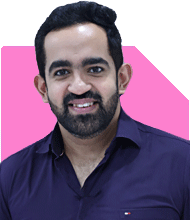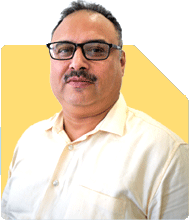Ramalingam Kalirajan |8092 Answers |Ask -Follow
Mutual Funds, Financial Planning Expert - Answered on Jul 12, 2024
He has an MBA in finance from the University of Madras and is a certified financial planner.
He is the director and chief financial planner at Holistic Investment, a Chennai-based firm that offers financial planning and wealth management advice.... more

Dear Sir, I am an NRI, 40 year old, have 2 daughters (7 &3 years old). I have invested all in real estate till date i.e. 1.5 cr. From now onwards I would like to start monthly SIP with an amount of INR 1 lakh. Please advice best mutual funds or category of funds to start with. Thanks.
Understanding Mutual Funds
Mutual funds pool money from various investors to invest in securities like stocks, bonds, and other assets. They offer diversification, professional management, and liquidity, making them a popular investment choice.
Importance of Diversification
Investing solely in real estate, as you have done so far, has its benefits but also carries risks, including liquidity issues and market fluctuations. Diversifying into mutual funds will help spread your risk and potentially increase your returns.
Categories of Mutual Funds
Equity Funds
Equity funds invest in stocks and have the potential for high returns. They are ideal for long-term goals due to their ability to outperform other asset classes over time. Here are some types of equity funds:
Large Cap Funds: These funds invest in large, well-established companies. They are relatively stable and less volatile.
Mid Cap Funds: These funds invest in medium-sized companies. They have higher growth potential but are more volatile than large-cap funds.
Small Cap Funds: These funds invest in smaller companies. They can offer high returns but come with significant risk and volatility.
Flexi Cap Funds: These funds invest across companies of different sizes and sectors, offering diversification and flexibility.
Sector Funds: These funds focus on specific sectors like technology, healthcare, or finance. They carry higher risk due to lack of diversification across sectors.
Debt Funds
Debt funds invest in fixed income instruments like bonds and treasury bills. They provide regular income with lower risk compared to equity funds. Suitable for short to medium-term goals, they are less volatile and offer steady returns.
Hybrid Funds
Hybrid funds invest in a mix of equity and debt instruments, balancing risk and reward. They are suitable for investors looking for moderate risk and balanced returns.
Balanced Advantage Funds: These funds dynamically manage their allocation between equity and debt based on market conditions.
Equity Savings Funds: These funds invest in equity, debt, and arbitrage opportunities, offering a mix of growth and stability.
Active vs. Index Funds
While index funds replicate market indices and are passively managed, actively managed funds seek to outperform the market through research and strategy. Active funds have the potential for higher returns due to the expertise of fund managers.
Direct vs. Regular Funds
Direct funds have lower expense ratios as they don't involve intermediaries. However, regular funds, recommended through a Certified Financial Planner (CFP), offer valuable guidance and advice. The expertise of a CFP can help you make informed decisions and achieve your financial goals effectively.
SIP Strategy for Your Goals
Starting a SIP of Rs. 1 lakh monthly is a wise decision. Here's a diversified approach across various fund categories:
For Long-Term Growth
Allocate a significant portion to equity funds for long-term wealth creation. Consider large-cap, mid-cap, and flexi-cap funds. They offer growth potential and can help you build a substantial corpus over time.
For Stability and Regular Income
Invest a portion in debt funds for stability and regular income. They can act as a cushion against market volatility and provide liquidity for short-term needs.
For Balanced Approach
Hybrid funds can offer a balanced mix of equity and debt. They are suitable for moderate risk tolerance and aim for steady growth.
Suggested Allocation
Equity Funds: 60% allocation can be divided into large cap, mid cap, and flexi cap funds. This will ensure growth potential while managing risk.
Debt Funds: 30% allocation to debt funds can provide stability and regular income. They are less volatile and offer steady returns.
Hybrid Funds: 10% allocation to hybrid funds can balance your portfolio, offering growth with controlled risk.
Monitoring and Rebalancing
Regularly monitor your investments to ensure they align with your goals. Rebalance your portfolio periodically to maintain the desired asset allocation. A CFP can help you with this process, ensuring your investments stay on track.
Benefits of SIP
Systematic Investment Plans (SIPs) offer several advantages:
Rupee Cost Averaging: SIPs spread your investment over time, buying more units when prices are low and fewer when prices are high. This averages out the cost and reduces the impact of market volatility.
Discipline and Convenience: SIPs promote disciplined investing by committing a fixed amount regularly. They are convenient and automated, making it easier to stick to your investment plan.
Compounding Effect: Regular investments benefit from compounding, where returns generate further returns. The longer you stay invested, the more significant the compounding effect.
Empathy and Understanding
I understand the importance of securing your daughters' future and ensuring a comfortable retirement. Your decision to diversify and invest in mutual funds reflects your foresight and commitment to financial planning. It’s a significant step towards achieving your financial goals.
Final Insights
Investing in mutual funds through SIPs is a smart way to diversify and grow your wealth. By choosing a mix of equity, debt, and hybrid funds, you can balance risk and reward. Regular monitoring and rebalancing will keep your investments aligned with your goals. Working with a Certified Financial Planner can provide the expertise and guidance needed to navigate your financial journey.
Best Regards,
K. Ramalingam, MBA, CFP,
Chief Financial Planner,
www.holisticinvestment.in
You may like to see similar questions and answers below
Omkeshwar Singh | Answer |Ask -Follow
Head, Rank MF - Answered on Apr 05, 2022
Omkeshwar Singh | Answer |Ask -Follow
Head, Rank MF - Answered on May 30, 2022
Ulhas Joshi | Answer |Ask -Follow
Mutual Fund Expert - Answered on Oct 26, 2023
Ramalingam Kalirajan |8092 Answers |Ask -Follow
Mutual Funds, Financial Planning Expert - Answered on May 11, 2024
Nayagam P P |4311 Answers |Ask -Follow
Career Counsellor - Answered on Mar 10, 2025
Aamish Dhingra |13 Answers |Ask -Follow
Life Coach - Answered on Mar 10, 2025
Milind Vadjikar |1097 Answers |Ask -Follow
Insurance, Stocks, MF, PF Expert - Answered on Mar 10, 2025
Milind Vadjikar |1097 Answers |Ask -Follow
Insurance, Stocks, MF, PF Expert - Answered on Mar 10, 2025
Sushil Sukhwani |589 Answers |Ask -Follow
Study Abroad Expert - Answered on Mar 10, 2025
Radheshyam Zanwar |1398 Answers |Ask -Follow
MHT-CET, IIT-JEE, NEET-UG Expert - Answered on Mar 10, 2025
Baqar Iftikhar Naqvi |113 Answers |Ask -Follow
Start-up Mentor - Answered on Mar 10, 2025
Patrick Dsouza |1005 Answers |Ask -Follow
CAT, XAT, CMAT, CET Expert - Answered on Mar 10, 2025
Radheshyam Zanwar |1398 Answers |Ask -Follow
MHT-CET, IIT-JEE, NEET-UG Expert - Answered on Mar 10, 2025
Prof Suvasish Mukhopadhyay |480 Answers |Ask -Follow
Career Counsellor - Answered on Mar 10, 2025





























